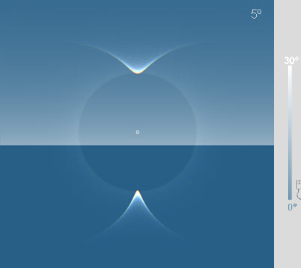Tangent Arcs
Tangent Arcs: A Phenomenon of Changing Sun Altitude
Atmospheric optics is a fascinating field that explores the beautiful and intricate phenomena that occur in our sky. One such phenomenon is the formation of tangent arcs. Tangent arcs are arcs of light that appear tangent to the 22º halo, a circular halo that encircles the sun or moon. These arcs change shape as the altitude of the sun changes throughout the day, creating a mesmerizing display of light and color.
When the sun is on the horizon, both the upper and lower tangent arcs appear as narrow 'V' shapes. As the sun begins to ascend, the upper tangent arc opens up and takes on a shape reminiscent of a gull's wings. This change in shape is due to the bending of sunlight as it passes through ice crystals in the atmosphere. The crystals act as prisms, refracting the light and causing it to spread out into an arc.
As the sun reaches an altitude of 29º, an interesting phenomenon occurs. The upper tangent arc connects with the lower tangent arc, forming what is known as the "circumscribed halo." This halo appears as a complete circle around the sun or moon, with the tangent arcs serving as its upper and lower boundaries. The circumscribed halo is a rare and captivating sight to behold.
Meanwhile, the lower tangent arc undergoes its own transformation. As the sun continues to ascend, the lower arc narrows and then broadens again. However, it is important to note that the lower arc is typically below the horizon when the sun is less than 22º high. Nevertheless, it can still be observed from elevated locations such as mountains or aircraft.
The shape-shifting nature of tangent arcs adds to their allure and makes them a subject of interest for atmospheric optics enthusiasts. As the sun's altitude changes throughout the day, these arcs provide a visual representation of how atmospheric conditions affect the behavior of light. It is a reminder of the complex interactions between sunlight, ice crystals, and our atmosphere.
In conclusion, tangent arcs are a captivating atmospheric optics phenomenon that occurs when the sun's altitude changes. These arcs, which appear tangent to the 22º halo, change shape as the sun ascends or descends in the sky. From narrow 'V' shapes on the horizon to connecting with the lower arc to form the circumscribed halo, tangent arcs offer a visually stunning display. Observing these arcs provides insights into the behavior of light in our atmosphere and serves as a testament to the beauty and complexity of nature.

Upper and lower tangent arcs and a faint 22º halo. HaloSim3 simulation. The region below the horizon is dark blue.
Tangent arcs alter shape as the sun's altitude changes. Mouse slowly over the slider to see them.
When the sun is on the horizon, both arcs are narrow 'Vs'. As the sun climbs the upper tangent arc opens and then droops like a gull's wings.
When the sun reaches 29º the upper arc links with the lower to become the "circumscribed halo".
The lower tangent arc narrows and then broadens again as the sun ascends. Of course, the lower arc is below the horizon when the sun is less than 22º high. Even so, it can still be seen from mountains or aircraft.
Note: this article has been automatically converted from the old site and may not appear as intended. You can find the original article here.
Reference Atmospheric Optics
If you use any of the definitions, information, or data presented on Atmospheric Optics, please copy the link or reference below to properly credit us as the reference source. Thank you!
-
<a href="https://atoptics.co.uk/blog/tangent-arcs-2/">Tangent Arcs</a>
-
"Tangent Arcs". Atmospheric Optics. Accessed on November 21, 2024. https://atoptics.co.uk/blog/tangent-arcs-2/.
-
"Tangent Arcs". Atmospheric Optics, https://atoptics.co.uk/blog/tangent-arcs-2/. Accessed 21 November, 2024
-
Tangent Arcs. Atmospheric Optics. Retrieved from https://atoptics.co.uk/blog/tangent-arcs-2/.